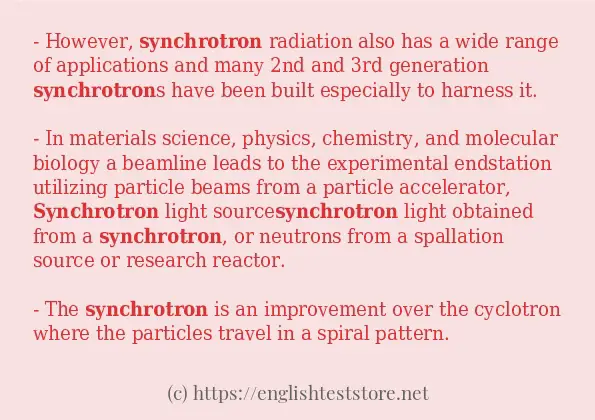How to use in-sentence of “synchrotron”:
– However, synchrotron radiation also has a wide range of applications and many 2nd and 3rd generation synchrotrons have been built especially to harness it.
– In materials science, physics, chemistry, and molecular biology a beamline leads to the experimental endstation utilizing particle beams from a particle accelerator, Synchrotron light sourcesynchrotron light obtained from a synchrotron, or neutrons from a spallation source or research reactor.
– The synchrotron is an improvement over the cyclotron where the particles travel in a spiral pattern.
– There is a huge amount of radio emission called synchrotron emission.
– The Advanced Light Source at Lawrence Berkeley National Laboratory in Berkeley, CaliforniaBerkeley, California is a synchrotron light source.
– Many experiments using synchrotron light probe the structure of matter from the sub-nanometer level of electronic structure to the micrometer and millimeter level.

Example sentences of “synchrotron”:
– Regarding synchrotrons, a beamline is the instrumentation that carries beams of synchrotron radiation to an experimental end station, which uses the radiation produced by the bending magnets and insertion devices in the storage ring of a synchrotron light source.
– While there is still potential for yet more powerful proton and heavy particle cyclic accelerators, it appears that the next step up in electron beam energy must avoid losses due to synchrotron radiation.
– Wilson brought in the team that had built the Cornell synchrotron to help build the original 200 GeV accelerator.
– These deflections release synchrotron radiation.
– A synchrotron is a type of particle accelerator where particles travel around many times in a circle.
– Other synchrotron labs, such as the Lawrence Berkeley Lab did not have enough energy to discover new particles.
– Antiprotons were first produced and identified in 1955 by Emilio Segrè, Owen Chamberlain, and coworkers by bombarding a copper target with high-energy protons from the proton synchrotron at the University of California at Berkeley.
– Although X-ray equipment is commonplace, crystallography often uses special synchrotron light sources to make X-rays.
– A synchrotron light source is a source of electromagnetic radiation produced by a synchrotron.
– Particles are injected into the main ring at substantial energies by either a linear accelerator or by an intermediate synchrotron which is in turn fed by a linear accelerator.
– Scientists also use synchrotron light in many other ways.
– A large synchrotron laboratory will have many beamlines, each optimized for a particular field of research.
– Superficially, neutron beamlines differ from synchrotron radiation beamlines mostly by the fact that they use neutrons from a research reactor or a spallation source instead of photons.
– Construction costs increased as synchrotrons got bigger to the point that many nations joined to build just one very big synchrotron in Europe to conduct atom smashing experiments.
– Since 2007, tooth age can be directly calculated using the noninvasive imaging of growth patterns in tooth enamel by means of x-ray synchrotron microtomography.
– Another early large synchrotron is the Cosmotron built at Brookhaven National Laboratory which reached 3.3 GeV in 1953.
– When the particles have reached their maximum energy, they are steered out of the synchrotron and aimed at a target.
– The largest of those 3rd generation synchrotron light sources are the European Synchrotron Radiation Facility near Chicago, USA, and SPring-8 in Japan, accelerating electrons up to 6, 7 and 8 GeV, respectively.
- Regarding synchrotrons, a beamline is the instrumentation that carries beams of synchrotron radiation to an experimental end station, which uses the radiation produced by the bending magnets and insertion devices in the storage ring of a synchrotron light source.
- While there is still potential for yet more powerful proton and heavy particle cyclic accelerators, it appears that the next step up in electron beam energy must avoid losses due to synchrotron radiation.
